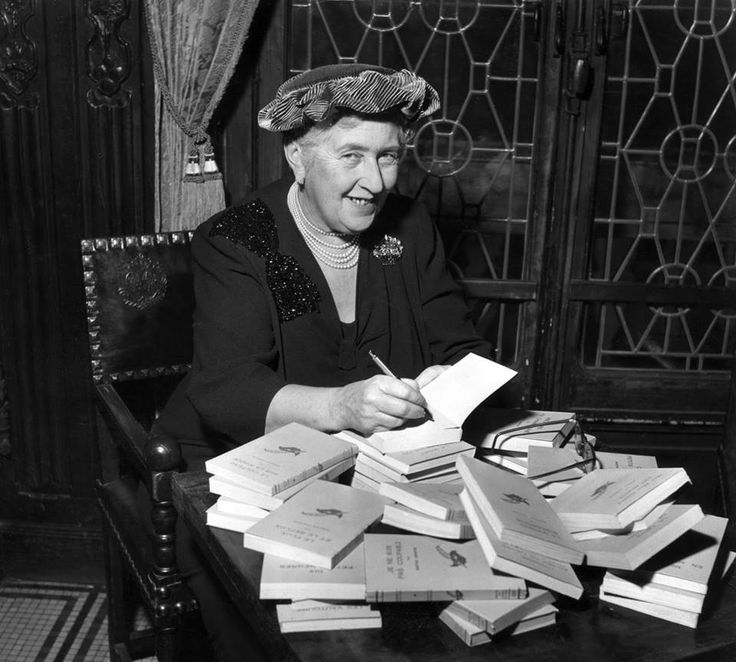 |
| (image from here) |
"'Oh Poirot,' I cried. 'It can't be natural death! It's got to be murder!'
'Oh la la, we seem to have changed places, you and I.'"
Dumb Witness, p. 220
The Sum of It:
Our story this week begins (quite literally!) with a death: that of Ms. Emily Arundell. Emily Arundell is a secretly-uber-wealthy spinster woman with many needy nieces and nephews, all of whom decide Easter weekend is the perfect time for a family reunion at which to beg Aunt Emily for some of her money. During said holiday weekend, Emily falls down the stairs in the nighttime, an incident which is unfortunately blamed on her darling dog Bob and his allegedly left upon the stairs ball! But is that really what happened? Ms. Arundell doesn't think so and writes a letter to Poirot about her concerns, a letter which she hides from her nosy maidservants tucked away in her writing-case (#snailmail). ALAS, she turns up dead some weeks later and her maidservant mournfully finds the unsent letter and says "Oh I'll be a good servant and send this for my poor dead mistress" (of course not knowing who Poirot is and why Emily Arundell sent him a letter). Poirot receives said letter many weeks after Ms. Arundell initially writes it, a fact which intrigues him instantly.
Poirot and Hastings, under the guise of being a Mr. Parotti & Plus One who are alternately researching for a book on the super en vogue topic of lesser known generals in the Indian Munity (#someonesgottadoit), looking to buy some real estate in the countryside, or having vague liver diseases, scour the small village of Market Basing for clues of the cause of Emily Arundel's eventual demise. They finally dispense with the theatrics (after Hastings starts feeling bad about the web of lies and also people find out it's THE Hercule Poirot and put two and two together) and investigate the case FOR REALZ. After many interviews with Emily Arundell's frankly super shady relatives Theresa, Charles, and Bella (#moneygrubbers), as well as her household staff, occult-loving neighbors, and recently-ish acquired paid companion (and soul recipient of Emily's VAST fortune), Miss Lawson, Poirot and Hastings sit back and think about the facts they have gathered and try to piece together whether they are dealing with a natural liver-failure death or #MURDER.
The YOA Treatment:
We were a bit saddened to realize that Dumb Witness is the penultimate Poirot book featuring Hastings as a narrator/sidekick/BFF! As always, their banter is really terrific in this book. Here are some of our favorite moments:
"Dear me," I complained. "There is something about this place that makes me feel extremely conspicuous. As for you, Poirot, you look positively exotic."
"You think it is noticed that I am a foreigner—yes?"
"The fact cries aloud to heaven," I assured him.
"And yet my clothes are made by an English tailor," mused Poirot.
(Chapter 6)
"Poirot," I said. "Have we got to listen at doors?"
"Calm yourself, my friend. It was only I who listened! It was not you who put your ear to the crack. On the contrary, you stood bolt upright like a soldier."
(Chapter 15)
We also enjoyed seeing Agatha's love for dogs shine from her adorable character, Bob the dog. Agatha has sprinkled a bit of Bob "dialogue" throughout the book and the result is so charming that even anti-pet Poirot is won over:
"Good watchdog, aren't I? he seemed to be saying. "Don't mind me! This is just my fun! My duty too, of course. Just have to let 'em known there's a dog about the place! Deadly dull morning. Quite a blessing to have something to do. Coming into our place? Hope so. It's durned dull. I could do with a little conversation."
"Hullo, old man," I said and shoved forward a fist.
Craning his neck through the railings he sniffed suspiciously, then gently wagged his tail, uttering a few, short, staccato barks.
"Not been properly introduced, of course, have to keep this up! But I see you know the proper advances to make."
"Good old boy," I said.
"Wuff," said the terrier amiably.
(Chapter 6)
David Suchet also writes in his memoir, Poirot and Me, about being "captivated" by Bob the dog on the set of the film Dumb Witness (shown in photo below played by the adorable terrier named Snubby!)
 |
| (image from here) |
Overall, we came away from Dumb Witness appreciating it as a rather classic-feeling Christie. While the plot and character development didn't really stand out, the whimsical Bob and delightful Poirot/Hastings dynamic we know and love made for an enjoyable read.
-A. & E.



















